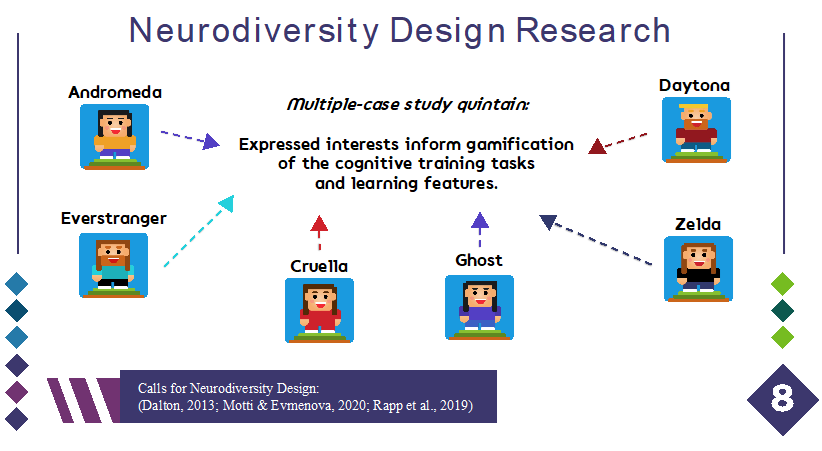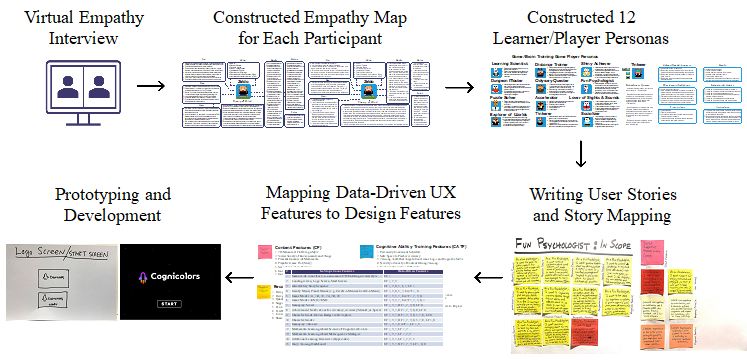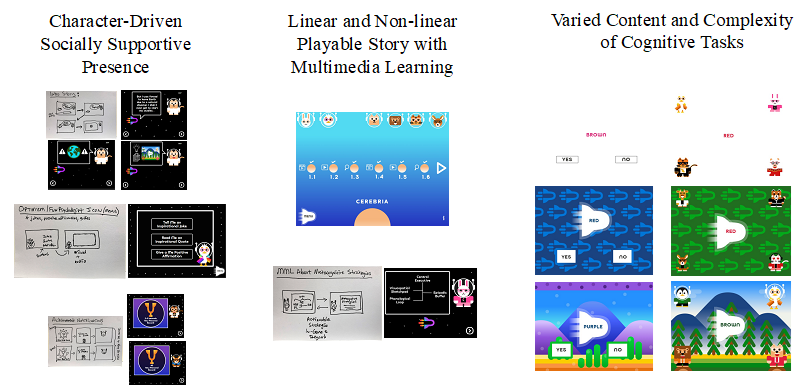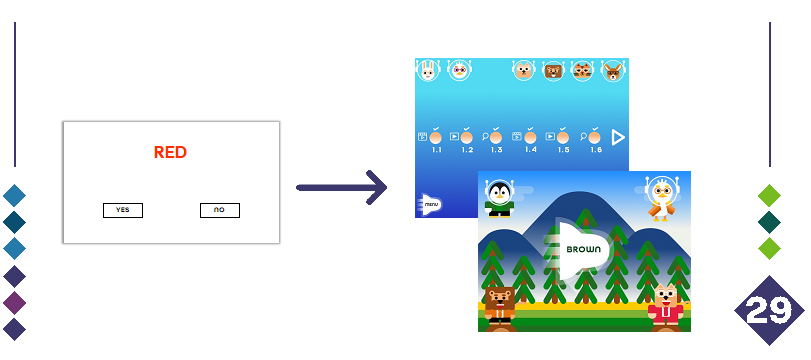A Neurodiversity Design Approach to Design Research About Gamification of Cognitive Ability Training and Learning
Introduction
In 2012 I would come home, turn on my television, and see commercials about brain training games like Lumosity from Lumos Labs Inc. and Jungle Rangers from Focus Education. The companies’ commercials advertised the promise of being able to play a game which could train one’s basic cognitive abilities to have far transfer to complex cognition and benefits for one’s everyday life. These promises led me to not only want to play this kind of game, but also want to make a similar game to help people. With this passion to make a brain training game, I looked at these companies’ websites at the time and saw indications the games were based on science. I formed an impression: if multiple companies are making brain training games and claiming they are based on science, then the science on which the games are based must say something about how to make these games effective.
When I began exploring the brain training game literature, I expected to find something both actionable and empirically supported, much like what we find from the multimedia learning literature about multimedia learning design principles. However, what I found in the brain training games literature – and monitored for a decade – was an academic reaction to companies’ commercial promises by examining the effectiveness of commercial products with a cognitive consequences approach to studying near and far transfer, as well as accusations of commercial overexaggeration beyond available evidence. I did not find a set of actionable, empirically supported design and development processes or design strategies, guidelines, or principles for creating cognitive ability training game tasks or other learning features in them.
What I did not expect to find, yet did find, was not only overexaggeration about the benefits of playing several companies’ products, but also a trend amongst several companies which marketed their brain training game or service as a cure for ADHD and “symptoms” of autism, as if these are diseases to be cured (FTC, 2015; FTC, 2016; Furfaro, 2018). However, ADHD and autism are neurodevelopmental conditions and a part of human diversity, not diseases (Bennet et al., 2019; Robertson, 2009). My passion to try to make a brain training game based on science was let down by the lack of actionable, empirically supported design science in the brain training games literature. My other passion to make learning experiences in a brain training game for anyone to learn from without obstacles was let down by the presence of cure language about neurodevelopmental conditions. Holding on to these two passions, I wanted to begin to address both problems with a study which aims to lead the design of learning features in a cognitive ability training game with empathy for the expressed interests of a neurodiversity of adult learners about the learning features or experiences they want to have with such a game. This article characterizes the research questions, empathy-driven analysis methods, and design methods of the first Analysis, Design, and Development phases of Phase 1 of that study.
Research Questions
To drive the design of the learning features of the cognitive ability training game with empathy about participants’ expressed interests, I formed the following research questions:
What are interested adult learners’ expressed interests in gamification features and learning features for a cognitive ability training game?
How can we design learning experiences in a cognitive ability training game to support personally meaningful learning by a neurodiversity of adult learners interested in learning about cognitive abilities, cognitive ability training, or cognitive health?
Neurodiversity Design and Participants
There is no normal brain (Armstrong, 2015) for which to design learning, so this study pursues an ethical shift away from medicalization of messages about people with ADHD or cures for them. This study shifts design research towards empathizing with and considering the expressed interests of people with and without diagnoses of neurodevelopmental conditions. A Neurodiversity Design approach (Dalton, 2013; Motti & Evmenova, 2020; Rapp et al., 2019) calls for including participants with neurodevelopmental conditions (e.g., ADHD or autism) and participants without neurodevelopmental conditions in the same design research study. The study did not plan to design for specificity of learner types or interests, nor a discoverable generality of learner types or interests. Instead, the study planned to design for including and supporting a diversity of learners (see Figure 1) by getting to know them, empathizing with their expressed interests, translating their interests into feature designs, and developing a game that supports each of them to experience learner agency for pursuing their learning interests with the game.
Figure 1
Neurodiversity Design with 6 Participants

The study included total of 6 participants, and I allowed them to pick their own pseudonyms as a method of engaging their interests and participation in the study: 2 adults with no neurodevelopmental conditions (Cruella and Ghost); 1 adult diagnosed with autism (Andromeda); 1 adult diagnosed with ADHD and autism (Everstranger); 2 adults diagnosed with ADHD (Daytona and Zelda).
Design Research Methodology
The neurodiversity design research process in this study blends techniques from design thinking and user experience (UX) design (e.g., empathy maps and personas) with other research methods (e.g., interviews; member checking; participant observation; journaling; and thematic analyses) to inform learning experience design processes. Since this study values both working software and documenting relationships between data, design strategies, and game features, I organized the overall process within a non-waterfall version of Analysis, Design, Development, Implementation, and Evaluation (ADDIE). As a domain-and-theory-agnostic process (Molenda, 2003), ADDIE can form a responsive approach with design thinking and iterative development. Since this article is focused on empathy and translating expressed interests into design, the activities from Implementation and Evaluation phases of Phase 1 of this design research project are beyond the scope of this paper.
Empathizing with Participants’ Expressed Interests
Analysis phase activities included initial 60-minute interviews with participants, thematic analyses (Braun & Clarke, 2006; Saldaña, 2015) of the interviews and notes to produce player-level themes, creation of empathy maps (Gray, 2017; Schmidt, 2021; Schmidt & Tawfik, 2022) that bring design empathy to player-level themes, member checking interview notes and empathy maps with participants, and construction of personas from empathy maps (18F (n.d.); Schmidt, et al., 2020; Schmidt & Tawfik, 2022) with persona-specific user story maps (Kaley, 2021; Scaled Agile, Inc., 2022). Table 1 below summarizes player-level themes about each participant’s expressed interests in features or experiences with a cognitive ability training game.
Table 1
Participants’ Expressed Interests
Name | Expressed Interests in Features or Experiences |
|---|---|
Andromeda |
|
Cruella |
|
Daytona |
|
Everstranger |
|
Ghost |
|
Zelda |
|
Translating Participants’ Interests into Feature Ideation
I used persona-aligned stories to guide ideation about game features, and mapping user stories (Kaley, 2021; Scaled Agile, Inc., 2022) with benefit hypotheses (Scaled Agile, Inc., 2023a; b), and acceptance criteria (Kaley, 2021; Scaled Agile, Inc., 2022) for features aligned to personas and participant’s expressed interests and personas. Next, I combined related user stories with notes about needed multimedia features in storyboarding (18F (n.d.)), and created low fidelity paper prototypes (18F (n.d.); Schmidt, et al., 2020). Figure 2 provides an overview of this process.
Figure 2
A Design Research process for translating empathy about expressed interests into design and development

Developing Features Based on Participants’ Interests
Development activities included creating low fidelity paper prototypes (18F (n.d.)) and then creating game art in Sketch and functional prototypes (18F (n.d.); Schmidt, et al., 2020) of the game-based learning environment in Articulate Storyline, including any needed audio, gamification, and learning features. Example prototypes are shown in Figure 3.
Figure 3
Three Examples of Feature Sets Designed and Developed Based on Empathy for Participants’ Interests

Conclusions
This study was an opportunity to call into question my own assumptions about what a cognitive ability training game mode should be like, as well as an opportunity to innovate based on empathizing with a neurodiversity of adult learners’ interests in playing and learning from such a game. For example, prior to approving this study, when the IRB asked me for a visual prototype for a concept of a game task, I made a basic Stroop task with a color word stimulus and two response items (yes and no) on a white background, since this is what the Stroop task literature has researched. However, several participants would have put this kind of game mode down, given its lack of variety of content and task complexity (i.e., given its lack of fit with their interests). By empathizing with participants’ interests and threading their interests into the design and development process, I was able to mix strategies to make a cognitive ability training game that not only allows them access to game modes with a variety of task complexities, but also interweaves multimedia learning opportunities into a playable story. The evolution of this development is seen in Figure 4.
Figure 4
Mixing strategies: Playable story with a variety of content, complexity of tasks, and multimedia learning

References
18F. (n.d.-a). A collection of tools to bring human-centered design into your project. U.S. General Services Administration. Retrieved March 31, 2024, from https://methods.18f.gov/
18F. (n.d.-b). Personas. U.S. General Services Administration. Retrieved March 31, 2024, from
https://methods.18f.gov/decide/personas/
18F. (n.d.-c). Prototyping. U.S. General Services Administration. Retrieved March 31, 2024, from
https://methods.18f.gov/make/prototyping/
18F. (n.d.-d). Storyboarding. U.S. General Services Administration. Retrieved March 31, 2024, from https://methods.18f.gov/decide/storyboarding/
Armstrong, T. (2015). The myth of the normal brain: Embracing neurodiversity. AMA journal of ethics, 17(4), 348-352. https//doi.org/10.1001/journalofethics.2015.17.4.msoc1-1504
Braun, V., & Clarke, V. (2006). Using thematic analysis in psychology. Qualitative research in psychology, 3(2), 77-101. https://doi.org/10.1191/1478088706qp063oa
Dalton, N. S. (2013). Neurodiversity HCI. Interactions, 20(2), 72-75. https://doi.org/10.1145/2468356.2468752
Federal Trade Commission (FTC). (2015). Makers of Jungle Rangers computer game for kids settle FTC charges that they deceived consumers with baseless “Brain Training” claims (Press Release). Retrieved from FTC website: https://www.ftc.gov/news-events/press- releases/2015/01/makers-jungle-rangers-computer-game-kids-settle-ftc-charges-they
Federal Trade Commission (FTC). (2016). Cognition omission: FTC says LearningRx claims not supported by sound science (Press Release). Retrieved from FTC website: https://www.ftc.gov/news-events/blogs/business-blog/2016/05/cognition-omission-ftc- says-learningrx-claims-not-supported
Furfaro, H. (2018, June 28). Despite dearth of data, firms sell brain training as autism antidote. Spectrum. Retrieved from https://www.spectrumnews.org/news/despite-dearth-data-firms-sell-brain-training-autism-antidote/
Gray, D. (2017, July 15). Updated Empathy Map Canvas. Medium. Retrieved from https://medium.com/@davegray/updated-empathy-map-canvas-46df22df3c8a and https://gamestorming.com/wp-content/uploads/2017/07/Empathy-Map-Canvas-006.pdf
Kaley, A. (2021, January 24). Mapping User Stories in Agile. Nielsen Norman Group. Retrieved from https://www.nngroup.com/articles/user-story-mapping/
Molenda, M. (2003). In search of the elusive ADDIE model. Performance improvement, 42(5), 34-37. https://doi.org/10.1002/pfi.4930420508
Motti, V. G., & Evmenova, A. (2020). Designing technologies for neurodiverse users: Considerations from research practice. In: Ahram T., Taiar R., Colson S., Choplin A. (Eds.), Human Interaction and Emerging Technologies. IHIET 2019. Advances in Intelligent Systems and Computing, vol 1018. Springer, Cham. https://doi.org/10.1007/978-3-030-25629-6_42
Rapp, A., Cena, F., Frauenberger, C., Hendriks, N., & Slegers, K. (2019). Designing mobile technologies for neurodiversity: Challenges and opportunities. In MobileHCI'19 Proceedings of the 21st International Conference on Human-Computer Interaction with Mobile Devices and Services. ACM. https://doi.org/10.1145/3338286.3344427
Robertson, S. M. (2009). Neurodiversity, quality of life, and autistic adults: Shifting research and professional focuses onto real-life challenges. Disability Studies Quarterly, 30(1). http://dx.doi.org/10.18061/dsq.v30i1.1069.
Saldaña, J. (2015). The coding manual for qualitative researchers. London: Sage.
Scaled Agile, Inc. (2022, December 7). Story. Scaled Agile Framework (SAFe). Retrieved from https://scaledagileframework.com/story/
Scaled Agile, Inc. (2023a, February 13). Design Thinking. Scaled Agile Framework (SAFe). Retrieved from https://scaledagileframework.com/design-thinking/
Scaled Agile, Inc. (2023b, February 21). Lean UX. Scaled Agile Framework (SAFe). Retrieved from https://scaledagileframework.com/lean-ux/
Schmidt, M. (2021). Empathy and relevance in learning experience design through persona development. [Webinar]. AECT. Recording available: https://youtu.be/j9e0-UcAFXQ
Schmidt, M., Earnshaw, Y., Tawfik, A.A., & Jahnke, I. (2020). Methods of user-centered design and evaluation for learning designers. In Learner and User Experience Research. EdTech Books. https://edtechbooks.org/ux/ucd_methods_for_lx
Schmidt, M., & Tawfik, A. A. (2022). Activity theory as a lens for developing and applying personas and scenarios in learning experience design. The Journal of Applied Instructional Design, 11(1), 55-73. https://doi.org/10.59668/354.5904
Stroop, J. R. (1935). Studies of interference in serial verbal reactions. Journal of experimental psychology, 18(6), 643.
Acknowledgments
Thank you to Andromeda, Cruella, Daytona, Everstranger, Ghost, and Zelda for donating your interests, energy, and time to this study. I am forever grateful to have come to know you and your interests in cognitive ability training. Your participation made this game and research about the strategies and process behind its design possible.